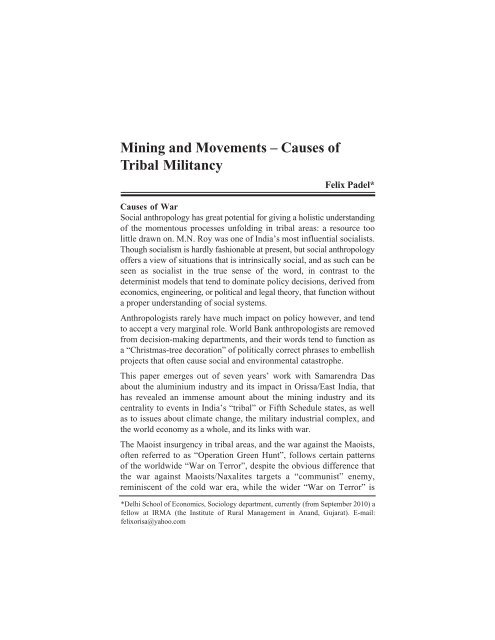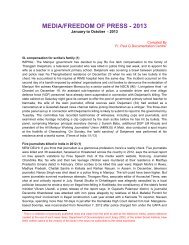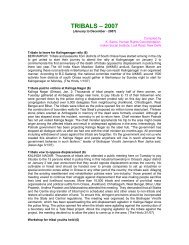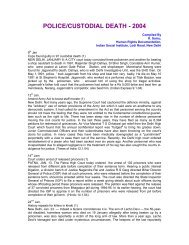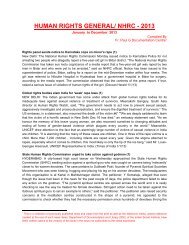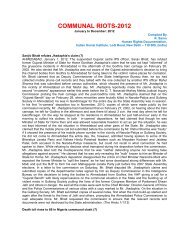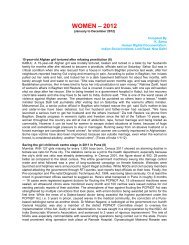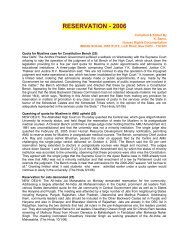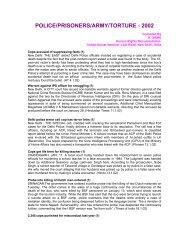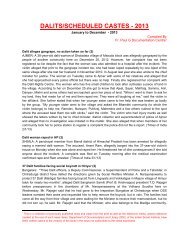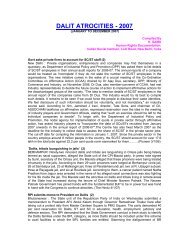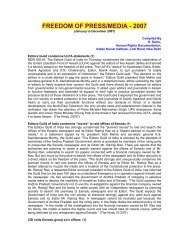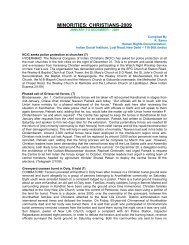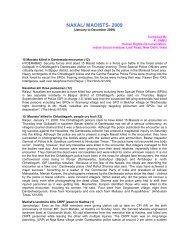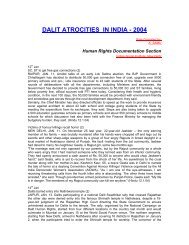Mining and Movements - Causes of Tribal Militancy - Indian Social ...
Mining and Movements - Causes of Tribal Militancy - Indian Social ...
Mining and Movements - Causes of Tribal Militancy - Indian Social ...
Create successful ePaper yourself
Turn your PDF publications into a flip-book with our unique Google optimized e-Paper software.
MINING AND MOVEMENTS – CAUSES OF TRIBAL MILITANCY 221<strong>Mining</strong> <strong>and</strong> <strong>Movements</strong> – <strong>Causes</strong> <strong>of</strong><strong>Tribal</strong> <strong>Militancy</strong>Felix Padel*<strong>Causes</strong> <strong>of</strong> War<strong>Social</strong> anthropology has great potential for giving a holistic underst<strong>and</strong>ing<strong>of</strong> the momentous processes unfolding in tribal areas: a resource toolittle drawn on. M.N. Roy was one <strong>of</strong> India’s most influential socialists.Though socialism is hardly fashionable at present, but social anthropology<strong>of</strong>fers a view <strong>of</strong> situations that is intrinsically social, <strong>and</strong> as such can beseen as socialist in the true sense <strong>of</strong> the word, in contrast to thedeterminist models that tend to dominate policy decisions, derived fromeconomics, engineering, or political <strong>and</strong> legal theory, that function withouta proper underst<strong>and</strong>ing <strong>of</strong> social systems.Anthropologists rarely have much impact on policy however, <strong>and</strong> tendto accept a very marginal role. World Bank anthropologists are removedfrom decision-making departments, <strong>and</strong> their words tend to function asa “Christmas-tree decoration” <strong>of</strong> politically correct phrases to embellishprojects that <strong>of</strong>ten cause social <strong>and</strong> environmental catastrophe.This paper emerges out <strong>of</strong> seven years’ work with Samarendra Dasabout the aluminium industry <strong>and</strong> its impact in Orissa/East India, thathas revealed an immense amount about the mining industry <strong>and</strong> itscentrality to events in India’s “tribal” or Fifth Schedule states, as wellas to issues about climate change, the military industrial complex, <strong>and</strong>the world economy as a whole, <strong>and</strong> its links with war.The Maoist insurgency in tribal areas, <strong>and</strong> the war against the Maoists,<strong>of</strong>ten referred to as “Operation Green Hunt”, follows certain patterns<strong>of</strong> the worldwide “War on Terror”, despite the obvious difference thatthe war against Maoists/Naxalites targets a “communist” enemy,reminiscent <strong>of</strong> the cold war era, while the wider “War on Terror” is*Delhi School <strong>of</strong> Economics, Sociology department, currently (from September 2010) afellow at IRMA (the Institute <strong>of</strong> Rural Management in An<strong>and</strong>, Gujarat). E-mail:felixorisa@yahoo.com
222SOCIAL ACTION VOL. 60 JULY – SEPTEMBER 2010mostly against Islamist militants. The Turkish situation, where the waragainst the Partiya Karkeren Kurdistan (PKK), (fighting for basic selfdeterminationby the Kurdish population) is <strong>of</strong>ten made to fit the mould<strong>of</strong> a war against terrorists, <strong>of</strong>fers a closer parallel to the situation incentral India – a parallel too little known in India.Central India’s Maoist/Naxalite insurgency adds complexity to a complextapestry <strong>of</strong> countless local movements against enforced displacement –movements that are essentially non-violent. “Displacement projects” isa fitting name for the new mining <strong>and</strong> metal factory “developmentprojects”, considering the number <strong>of</strong> people threatened with removalfrom their l<strong>and</strong> <strong>and</strong> communities. The movements are <strong>of</strong> globalsignificance for their assertion <strong>of</strong> people’s basic rights to life <strong>and</strong>livelihood, <strong>and</strong> for resistance to capitalist growth-oriented devouring <strong>of</strong>resources <strong>and</strong> wrecking <strong>of</strong> environment. Often these movements havebeen falsely br<strong>and</strong>ed as Maoist.When certain movements have received public support from the Maoists,this has <strong>of</strong>ten been a “kiss <strong>of</strong> death” to genuine, indigenous movements,by making a response <strong>of</strong> massive attack on communities by securityforces appear legitimate.So it is necessary to spell out that most local movements are not in anyway Maoist-instigated. For example, the movements in Orissa to saveNiyamgiri <strong>and</strong> the Puri area from Vedanta’s aluminium <strong>and</strong> universityplans, <strong>and</strong> the movement against giant new steel plants by Posco, theTatas <strong>and</strong> others all arise locally, in solidarity. The Kalinganagarmovement by the Bisthapan Birodhi Jan Manch (People’s PlatformAgainst Displacement) against a new Tata steel plant, is currently(since 27.3.2010) under attack by hundreds <strong>of</strong> police in collusion with‘goondas’ determined to mow down opposition to the Tatas.Similarly an Obey the Law movement in Birbhum district <strong>of</strong> WestBengal, organised by local Santal Adivasis along with Hindu <strong>and</strong> Muslimnon-tribals, is trying to stop several hundred illegal stone quarries thatare making their life hell. The mine owners, along with a section <strong>of</strong> thelocal administration <strong>and</strong> the media, have falsely br<strong>and</strong>ed the movement‘Maoist’.By contrast, certain other movements are essentially local, <strong>and</strong> non-Maoist, even though Maoists have expressed support, resulting in a
MINING AND MOVEMENTS – CAUSES OF TRIBAL MILITANCY 223spiralling escalation <strong>of</strong> attacks on tribal villages by the security forces.This applies to the Committee Against Police Atrocities organised bySantals in West Midnapore <strong>and</strong> neighbouring districts <strong>of</strong> West Bengal,<strong>and</strong> the Chasi Mulia Adivasi Sangho in the Narayanpatna area <strong>of</strong>Koraput district in south Orissa, where tribal villages are under attackby security forces, especially since the Narayanpatna police stationfiring on 20 November 2009 that killed two Adivasi leaders.The causes <strong>of</strong> tribal militancy – i.e. the reason that in certain areas,such as South Chhattisgarh, many tribal people have joined the Maoists– can be given as follows:1. The vast extent <strong>of</strong> exploitation which tribal communities face: asystem <strong>of</strong> endemic exploitation that works at many levels <strong>and</strong> hasbeen extensively documented, e.g. in Orissa by Kishen Pattnayakduring his 1960s <strong>and</strong> 1980s campaigns against “starvation deaths”<strong>and</strong> by Gopinath Mohanty, P. Sainath, <strong>and</strong> others. This exploitationis compounded by the invasion <strong>of</strong> mining companies into tribalareas, <strong>and</strong> frequent suppression <strong>of</strong> local people’s non-violentmovements, st<strong>and</strong>ing up for the most basic <strong>of</strong> rights.2. The increasing scale <strong>of</strong> dispossession/displacement. A longtermprocess <strong>of</strong> displacement <strong>of</strong> Adivasis through money lending<strong>and</strong> extensive purchases <strong>of</strong> tribal l<strong>and</strong> that contravene the FifthSchedule constitutional guarantees, is accelerating through numerousindustrial projects that raise exponentially the number <strong>of</strong> tribalpeople being dispossessed. An estimated 60 million village peoplehave been displaced by industries <strong>and</strong> dams in India since 1950,about half <strong>of</strong> these Adivasis <strong>and</strong> a quarter Dalits, 3 million inOrissa alone. This displacement process has also been vastlyaccelerated through war <strong>and</strong> conflict – especially the “SalwaJudum” war against Naxalites/Maoists in Dantewara district insouth Chhattisgarh, where at least 200,000 tribal people have beendriven out <strong>of</strong> their homes since 2005; <strong>and</strong> the “ethnic cleansing <strong>of</strong>Christians” that has displaced an estimated 50,000 people fromK<strong>and</strong>hamal district <strong>of</strong> Orissa in 2007-08 <strong>and</strong> 2008-2009.3. Atrocities committed with impunity by security forces/SalwaJudum, (SJ) Hiding behind the Armed Forces Special PowersAct (AFSPA), the special Chhattisgarh Security Act, etc. JavedIqbal’s <strong>and</strong> many other articles <strong>and</strong> several human rights reports
224SOCIAL ACTION VOL. 60 JULY – SEPTEMBER 2010have made clear a definite pattern <strong>of</strong> atrocities committed by SJ<strong>and</strong> security forces during attacks on tribal villages in southChhattisgarh, involving killings, rape, torture <strong>and</strong> burning <strong>of</strong> houseson a horrific scale. It is clear (e.g. from Arundhati Roy 29.3.10recording frank talks with Adivasi Maoists in south Chhattisgarh)that these attacks are a motivating force for thous<strong>and</strong>s <strong>of</strong> Adivasiswho join the Maoists. In other words, a main cause for militancy isquite simply injustice – the impossibility <strong>of</strong> redress for theseoutrages through the courts. Atrocities are fuelled by awidespread disrespect for tribal culture <strong>and</strong> norms. For instanceSantal elders at the start <strong>of</strong> the West Midnapore disturbances (end<strong>of</strong> 2008) dem<strong>and</strong>ed that senior policemen should make a properapology for widespread outrages, in the local tribal idiom. Whensuch an apology was not forthcoming, the militancy spread, <strong>and</strong>the police atrocities increased.4. Polarization into two sides who believe in war. Everywhere,attacks on tribal communities are starting to resemble an attack ontribal society itself (as B.D. Sharma warned in 1990, when he wasCommissioner for Scheduled Castes <strong>and</strong> Tribes) – in effect,“Operation <strong>Tribal</strong> Hunt”. The war against Maoists <strong>and</strong>/or tribalpeople has the character <strong>of</strong> a war between rich <strong>and</strong> poor, <strong>and</strong>specifically a war <strong>of</strong> state-facilitated mining companies againsttribal people in order to get hold <strong>of</strong> their l<strong>and</strong> <strong>and</strong> resources. Butwhere the Maoist leadership exactly mirrors the mainstream militaryis in its belief in war, <strong>and</strong> in the necessity <strong>of</strong> mass-scale sacrifice<strong>of</strong> human life. Maoist attacks that kill police tend to instigate ahuge retaliation <strong>of</strong> security force attacks on tribal villages. Behindthese attacks is the military-industrial complex, <strong>and</strong> its thirst forminerals, <strong>and</strong> a mentality in which displacement <strong>of</strong> tribal people tomake way for industry seems a matter <strong>of</strong> course.5. Taking these factors together, Operation Green Hunt – thewar against the Maoists – is itself the main cause <strong>of</strong> tribalmilitancy – a situation similar to the worldwide war on terror,where attacks on Iraq <strong>and</strong> Afghanistan have killed, maimed <strong>and</strong>humiliated so many thous<strong>and</strong>s <strong>of</strong> people, that a ‘terrorist’ causewith very limited appeal has grown exponentially, as in the Greekmyth <strong>of</strong> the Hydra – every ‘arm’ the hero cuts <strong>of</strong>f the Hydra is
MINING AND MOVEMENTS – CAUSES OF TRIBAL MILITANCY 225replaced by countless new arms. “Terrorism” is essentially a creation<strong>of</strong> the “War on Terror” – not least because the use <strong>of</strong> terror bysecurity forces far outweighs the use <strong>of</strong> terror by “terrorists”.This applies very clearly to the situation in tribal areas, where bothsides use terror, but the main terror unleashed in tribal villages isby security forces, not by Maoists. In other words, terror tacticsby the security forces are a main cause <strong>of</strong> the spread <strong>of</strong>tribal militancy, alongside repression <strong>of</strong> genuine, non-violentmovements against enforced displacement.Invasion <strong>of</strong> <strong>Mining</strong> Projects: Cost-Benefit AnalysisUnderlying local causes is the invasion <strong>of</strong> mining companies, some<strong>Indian</strong>, some foreign, but most driven by, or at least supported by,funding from foreign financial institutions. London is a prime centre <strong>of</strong>the mining industry, with the London Metal Exchange fixing the price <strong>of</strong>main non-ferrous metals through trading five days a week, the city’s‘Big Four’ accountancy firms providing ‘legitimacy’ to mining companies,<strong>and</strong> DFID-sponsored privatisation <strong>and</strong> deregulation schemes carriedout in key mineral-rich states – a reform programme attuned to WB/IMF-imposed neoliberal policies. Vedanta’s bid for Niyamgiri <strong>and</strong> otherareas followed its registration on the London Stock Exchange inDecember 2003. Essar is currently trying to register in London. SirRatan Tata was clearly made a Knight Comm<strong>and</strong>er <strong>of</strong> the BritishEmpire (2009) for services to British business, <strong>and</strong> Tata’s buy-up <strong>of</strong>Corus (British Steel, January 2007), Jaguar <strong>and</strong> Lan Rover (March2008) established London as a key base for the Tata group, <strong>and</strong>,presumably, its investors.A proper assessment <strong>of</strong> projects’ social <strong>and</strong> environmental impactsneeds to be made transparent. In other words, every project should bebased on a holistic cost benefit analysis, whose figures <strong>and</strong> terms <strong>of</strong>reference should be brought into the public domain, so that people canunderst<strong>and</strong> clearly what is at stake on both sides. Where there is notransparency, companies’ enforced takeover <strong>of</strong> tribal property wearsan illegitimate character, e.g. regarding Tata <strong>and</strong> Essar’s Memor<strong>and</strong>a<strong>of</strong> Underst<strong>and</strong>ing (MoUs) signed with the Chhattisgarh government inJune 2005 – just when Salwa Judum was formed. Public hearings forboth projects have been a shameful scam, in a pattern repeated inhundreds <strong>of</strong> instances throughout the country.
226SOCIAL ACTION VOL. 60 JULY – SEPTEMBER 2010In brief, “benefits” <strong>of</strong> mining <strong>and</strong> metal projects pushed by Tata, Posco,Vedanta, Essar, Hindalco, Mittal, Jindal <strong>and</strong> others include huge sums<strong>of</strong> foreign investment, the creation <strong>of</strong> numerous jobs, <strong>and</strong> the“development” <strong>of</strong> new roads <strong>and</strong> construction projects, including newports, as well as local projects, Corporate <strong>Social</strong> Responsibility (CSR)<strong>of</strong> local/peripheral development, to be paid for out–<strong>of</strong>– company pr<strong>of</strong>its.Against this is the mass displacement <strong>of</strong> small-scale skilled cultivatorswho are classed as “unskilled labour” <strong>and</strong> invariably lose to incomers inthe job market, as shown by a long history <strong>of</strong> demonstrations by localpeople on the jobs issue, in the Lanjigarh, Kashipur <strong>and</strong> perhaps everyindustrialising area. Foreign Direct Investment (FDI) essentially buysup rights to India’s non-renewable resources (l<strong>and</strong>, mountains, minerals),while the primary intention <strong>of</strong> new ports appears to be the mass-scaleexport <strong>of</strong> these minerals.The real costs <strong>of</strong> these projects need assessing in terms <strong>of</strong> huge subsidies<strong>of</strong>fered to the industries for electricity, l<strong>and</strong>, water, transport etc –costs, which are essentially borne by the local people <strong>and</strong> state, throughfurther loans aimed at financing the infrastructure for the mining industry– in a situation where Orissa is already India’s most highly indebtedstate.Also in terms <strong>of</strong> impacts on the environment in a situation where e.g.producing one tonne <strong>of</strong> steel consumes an estimated 44 tonnes <strong>of</strong>water, <strong>and</strong> producing one tonne <strong>of</strong> aluminium consumes an estimated1,378 tonnes <strong>of</strong> water. These figures underlie recent massdemonstrations by west Orissa farmers against the new steel plants<strong>and</strong> aluminium smelters taking water from Hirakud dam at farmers’expense. Mines <strong>and</strong> metal factories damage the reserves <strong>and</strong> circulation<strong>of</strong> water at many levels, in a context where ground water is goingdown almost everywhere, <strong>and</strong> availability <strong>of</strong> fresh water is rapidlyassuming crisis proportions.The mining/metal’s industry’s “externality costs” are prohibitive, e.g.producing one tonne <strong>of</strong> aluminium emits between 6 <strong>and</strong> 20 tonnes <strong>of</strong>CO 2, each tonne <strong>of</strong> which is costed at about $85. Attempts have beenmade to calculate some <strong>of</strong> these costs in monetary (chrematist) terms.But overall costs in terms <strong>of</strong> damage to the environment are impossibleto quantify or put a price on. Economists <strong>and</strong> engineers are not taught
MINING AND MOVEMENTS – CAUSES OF TRIBAL MILITANCY 227to underst<strong>and</strong> – let alone take responsibility for the impacts <strong>of</strong> theirprojects on the environment.‘Economics’ <strong>and</strong> ‘Ecology’ have the same root from Greek the word‘oikos’, meaning ‘house’, indicating the laws (nomos) or logic (logos) <strong>of</strong>correct ‘housekeeping’. Yet ecology is not even part <strong>of</strong> economists’<strong>and</strong> engineers’ training. In fact, science <strong>of</strong> nature is split up betweendiscrete branches – geology, soil science, botany, hydrology, meteorologyetc., so even here the holistic underst<strong>and</strong>ing <strong>of</strong> ecology necessary foran appraisal <strong>of</strong> industrial impacts is lacking.This lack is all too evident in assessments <strong>of</strong> the impacts <strong>of</strong> big dams:what does it mean when rivers’ flow over the l<strong>and</strong> is drasticallycurtailed? Obviously, fish populations <strong>and</strong> many other life forms die...What are the effects when industrial waste is released into rivers, ashas been well documented from Nalco’s Angul smelter, <strong>and</strong> already,within months <strong>of</strong> their starting up, from Vedanta’s Lanjigarh refinery<strong>and</strong> Burkhamunda smelter? Obviously, more fish <strong>and</strong> other life formsdie, <strong>and</strong> human communities that have always depended on these riversfor bathing, drinking <strong>and</strong> cultivation suffer immensely..... But are therivers themselves dying? The destructive effects <strong>of</strong> big dams, documentedat length by the World Commission on Dams, have not been <strong>of</strong>ficiallyrecognised in India. The country is trying to maximize its hydro-potentialby building a huge number <strong>of</strong> new mega-dams, including 150 in ArunachalPradesh alone, despite massive evidence <strong>of</strong> big dams’ destructive effectson many levels.This lack is also evident in the inadequacy <strong>of</strong> studies <strong>of</strong> the impact <strong>of</strong>mining on the water regime <strong>of</strong> mountains. The drying <strong>of</strong> thous<strong>and</strong>s <strong>of</strong>streams in iron-ore mined mountains in north Orissa is well known, <strong>and</strong>the drying <strong>of</strong> perennial streams around Panchpat Mali, the mountain inKoraput that forms Orissa’s major bauxite mine, is attested by localAdivasis. But in its report on likely impacts <strong>of</strong> Vedanta’s OMC-Sterlitemine planned on Niyam Dongar, the Central <strong>Mining</strong> Planning <strong>and</strong> DesignInstitute made the absurd argument that micro-cracks forming on theside <strong>of</strong> the mountain during mining will “facilitate run-<strong>of</strong>f” <strong>and</strong> help“recharge ground water”. When water runs straight <strong>of</strong>f a mountainduring the monsoon, this means that streams will run dry in the hotseason, <strong>and</strong> indicates that the mountain as a reservoir <strong>and</strong> source <strong>of</strong>perennial streams is damaged beyond repair.
228SOCIAL ACTION VOL. 60 JULY – SEPTEMBER 2010Bauxite deposits just below the summits <strong>of</strong> south Orissa’s biggestmountains hold monsoon water in suspension, releasing it slowlythroughout the year in perennial streams. When the bauxite is mined,this water runs straight <strong>of</strong>f, <strong>and</strong> streams dry up. But bauxite is studiedalmost entirely from the point <strong>of</strong> view <strong>of</strong> extracting <strong>and</strong> processing it bythe mining industry – not its links with hydrology etc.Similarly with the loss <strong>of</strong> forest. A “Green Accounting Project”, forwhich Deutsche Bank was a main funder, calculates the ‘Net PresentValue’ <strong>of</strong> forests (NPV), but this economic value placed on foreststakes little or no account <strong>of</strong> forests’ biodiversity, cultural value <strong>and</strong>other features. The judgement in the case on Niyamgiri by the SupremeCourt (8.8.2008) simply asked the Special Purpose Vehicle (i.e Vedanta’ssubsidiary Sterlite with the Orissa <strong>Mining</strong> Corporation) to pay NPVreplacement costs. Interestingly, Deutsche Bank is a key investor inVedanta. So in effect the foreign banks indirectly buying up rights tokey resources are also funding “green” studies that facilitate thiscorporate takeover.In all these ways, these mining projects have intensely destructive allroundeffects on the environment. What is happening should properlybe termed Ecocide, defined as“the extensive destruction, damage to <strong>and</strong> loss <strong>of</strong> ecosystem(s) <strong>of</strong> a given territory,whether by human agency or by other causes, to such an extent that peacefulenjoyment by the inhabitants <strong>of</strong> that territory has been severely diminished”.(Higgins 2010)This destruction needs to be seen as damaging the “sacred trust” byGovernments to promote the well-being <strong>of</strong> inhabitants <strong>of</strong> non-selfgoverningterritories, as defined by the 1945 UN charter (Chapter XIArticle 73). Most lawyers <strong>and</strong> legislators have little knowledge <strong>of</strong> ecology:“at the moment the governance systems <strong>of</strong> most countries <strong>and</strong> <strong>of</strong> the international‘community’ actually facilitate <strong>and</strong> legitimise the exploitation <strong>and</strong> destruction <strong>of</strong>Earth by humans.” (Cullinan 2002: 30).Ecocide being perpetrated by mining projects under a rationale <strong>of</strong>economic growth means a destruction <strong>of</strong> the fabric <strong>of</strong> life, <strong>and</strong> is theprime cause <strong>of</strong> unrest throughout Central India.Impacts on human populations displaced or invaded by the industry arefrequently catastrophic, <strong>and</strong> should properly be termed as culturicide or
MINING AND MOVEMENTS – CAUSES OF TRIBAL MILITANCY 229cultural genocide. <strong>Tribal</strong> communities in particular lose everything theytraditionally value when displaced: their social structure exists in relationto their l<strong>and</strong>, environment, <strong>and</strong> identity as skilled cultivators. From beingin control <strong>of</strong> their own environment <strong>and</strong> social relations, they findthemselves swamped by outsiders, at the bottom <strong>of</strong> a cruel <strong>and</strong> corruptcorporate hierarchy. From being largely self-sufficient in terms <strong>of</strong>producing food on their own l<strong>and</strong> by their own labour, they are reducedto an unskilled industrial labour force. Women <strong>and</strong> children, especiallyexperience a drastic drop in their st<strong>and</strong>ard <strong>of</strong> living, from a place <strong>of</strong>considerable independence in charge <strong>of</strong> growing <strong>and</strong> selling. Materialculture is changed beyond recognition – from houses people made out<strong>of</strong> natural materials, people are placed in concrete shells. Traditionalartefacts – <strong>of</strong>ten collected into a “tribal museum” during thedisplacement process – lose their meaning <strong>and</strong> become relics <strong>of</strong> thepast. <strong>Tribal</strong> people’s traditional forms <strong>of</strong> knowledge are undermined<strong>and</strong> negated.Gap Between Projection <strong>and</strong> Ground RealityEven World Bank studies conclude that the vast majority <strong>of</strong> tribalcommunities displaced by dams <strong>and</strong> industry in India, as worldwide,experience a drastic fall in their st<strong>and</strong>ard <strong>of</strong> living. For almost everyWorld Bank funded project, “the first rule...that all parties to theproject should be better <strong>of</strong>f” has been broken, <strong>and</strong> “projects meantto reduce poverty are the ones adding to the numbers <strong>of</strong> the poor.”In “packages” for the Resettlement <strong>and</strong> Rehabilitation (R & R) <strong>of</strong>people displaced by dams <strong>and</strong> factories there is a reality gap: nocorrelation between theory <strong>and</strong> practice – between what is supposed tohappen <strong>and</strong> facts on the ground.This reality gap is evident at many levels. Models <strong>of</strong> economic growthreducing poverty in schemes funded by World Bank loans <strong>and</strong> “foreignaid” from the Department for International Development <strong>of</strong> the UKGovernment (DFID) are basically a con, showing a fundamentaldisjunction between theory <strong>and</strong> practice. Projects bringing in foreigninvestment distort the economy <strong>and</strong> induce unrepayable debt – Enronwas a noteworthy early example in India. This in a context where the“black economy” <strong>of</strong> bribes <strong>and</strong> underh<strong>and</strong> payments is little studied,<strong>and</strong> virtually absent from conventional economic models, yet has amassive effect in motivating deals for projects.
230SOCIAL ACTION VOL. 60 JULY – SEPTEMBER 2010The split between economics <strong>and</strong> ecology is a sign <strong>of</strong> a fundamentalimbalance in the western-imported model <strong>of</strong> development being imposed,based on models <strong>of</strong> growth <strong>and</strong> extraction <strong>of</strong> resources that are insanelyshort-term. “Sustainable Development” is supposed to be based onpractices that do not jeopardise future generations, but there aresupposed to be three criteria: ecology, society <strong>and</strong> economics, <strong>and</strong> byprioritising economics instead <strong>of</strong> ecology, the term has becomemeaningless <strong>and</strong> is <strong>of</strong>ten used <strong>of</strong> projects that can make an economicpr<strong>of</strong>it for a few years.What about the next thous<strong>and</strong> years? The very tribal societies threatenedwith displacement by mining projects are based on long-termsustainability. How has an insane system that sacrifices these people<strong>and</strong> this principle <strong>of</strong> long-term sustainability managed to appear sonormal?The Roots <strong>and</strong> Funding <strong>of</strong> IndustrialisationBelief in “development”, defined around material constructs <strong>and</strong> economicgrowth, is basically a missionary concept. The East India Company hada complex relationship with Christian missionaries, basically forbidding<strong>and</strong> then encouraging them to “civilise the natives” through schools <strong>and</strong>hospitals, but the administrative role – as in other colonial systems –basically internalised the missionary impulse, transforming the missionaryidea that there is only one “God” or “truth” or path to salvation, into theidea that social evolution follows a single line <strong>of</strong> development. This“social evolutionism” dates back to Herbert Spencer’s application <strong>of</strong>Darwin’s theory <strong>of</strong> evolution <strong>of</strong> species to society: a theory that societyevolves in set stages. This theory has been extremely influential, notleast on Marxist theory. But the idea that societies evolve from “primitivecommunism” through feudalism to capitalism (<strong>and</strong> on to ‘advancedcommunism’ or not, as the case may be) ignores many levels.If the multitude <strong>of</strong> natural species have all evolved along thous<strong>and</strong>s <strong>of</strong>individual paths, always in relation to each other, why should humansocieties evolve along a single path? If no such law exists, then howhas the World Bank (not to mention Marxist <strong>and</strong> many other regimes)assumed a kind <strong>of</strong> “divine right” to impose such uniformity, based onversions <strong>of</strong> this theory, onto “developing countries”? Even theclassification <strong>of</strong> countries into “developed” <strong>and</strong> “developing” begs thisquestion.
MINING AND MOVEMENTS – CAUSES OF TRIBAL MILITANCY 231To put this another way, the system <strong>of</strong> beliefs <strong>and</strong> values drivingindustrialisation, being imposed in India’s tribal areas has foreign roots– basically, the history <strong>of</strong> industrialisation from Europe <strong>and</strong> the RobberBarons in the USA, through Stalin’s USSR <strong>and</strong> Mao’s China, to WorldBank/IMF ‘moneylender colonialism’, enmeshing the world’s ‘developingcountries’ in unrepayable debt to pay for a process <strong>of</strong> industrialisationthat has caused one environmental <strong>and</strong> social catastrophe after another.In the early days <strong>of</strong> social anthropology, anthropologists invariably sawtribal societies as “primitive”, <strong>and</strong> colonial anthropology defined tribalpeoples as “primitive” in every domain – a perception that persists inIndia, on the left as well as right. This idea is at the root <strong>of</strong> imposing“development” on Adivasis <strong>and</strong> displacing them from their l<strong>and</strong>.Modern anthropologists recognise that tribal societies are as highlydeveloped as mainstream societies – but in different ways. In terms <strong>of</strong>their knowledge <strong>of</strong> the environment, skills <strong>of</strong> living <strong>of</strong>f it without damagingit, sophistication <strong>of</strong> social relations around a principle <strong>of</strong> sharing, subtlety<strong>of</strong> rearing children <strong>and</strong> so on, they are <strong>of</strong>ten far in advance <strong>of</strong> mainstreamsociety. Hence the enormity <strong>of</strong> what is sacrificed <strong>and</strong> destroyed whena tribal community’s l<strong>and</strong> is invaded or taken away by a mining company:cultural genocide.But mining/metals projects are mostly funded from abroad, <strong>and</strong> foreigncities play an important role in their highly dispersed social structure.Several studies have been made <strong>of</strong> the foreign <strong>and</strong> <strong>Indian</strong> banks thathave invested in Vedanta <strong>and</strong> financed their projects in Orissa <strong>and</strong>Chhattisgarh, <strong>and</strong> each <strong>of</strong> the world’s ‘Big Four’ accountancy firmshas given ‘Assurance Statements’ validating the annual reports <strong>of</strong>Vedanta Resources plc. Traders at the London Metals Exchange, whosedeals in future contracts fix the price <strong>of</strong> aluminium five days a week,gain huge salaries. Prime investors in mining projects <strong>and</strong> <strong>Indian</strong> portconstruction projects include secretive hedge funds <strong>and</strong> private equityfunds, while overall finance to mining projects has increased enormouslysince 2000, along with risk insurance <strong>and</strong> export credit guarantees.Orissa is one <strong>of</strong> India’s most highly indebted states precisely because itis one <strong>of</strong> the richest in minerals. The loans paid for a long line <strong>of</strong> dam,coal <strong>and</strong> other infrastrusture-for-mining projects, <strong>and</strong> built up unrepayabledebts, make the state dependent on further loans from the World Bank<strong>and</strong> other entities, have given leverage that allowed the WB <strong>and</strong> DFID
232SOCIAL ACTION VOL. 60 JULY – SEPTEMBER 2010to force through India’s first electricity privatisation programme <strong>and</strong>other neoliberal reforms. This brings in the history <strong>of</strong> “disaster capitalism”<strong>and</strong> World Bank complicity in aluminium projects around the world.When one comprehends the extent <strong>and</strong> complexity <strong>of</strong> exploitation in themining-metals industry <strong>and</strong> trade, it is clear why the world’s, or India’s,mineral-richest areas are the poorest. Far from the promised prosperity,wealth in minerals almost invariably guarantees a region’s remorselessimpoverishment by exploitation: the resource curse.Motives for War <strong>and</strong> PeaceToo <strong>of</strong>ten, the resource-curse spirals into the horror <strong>of</strong> resource-wars,<strong>and</strong> in many ways, the war against the Maoists is a classic resource–war: the invasion <strong>and</strong> takeover <strong>of</strong> tribal l<strong>and</strong>s by mining companies,compounding already excessive exploitation. Non-violent protest issuppressed, <strong>and</strong> giving Maoists the chance to organise the dispossessedinto a desperate, yet highly organised <strong>and</strong> motivated resistance.The war in South Dantewada shows a definite pattern <strong>of</strong> “structuralviolence”. On one side, Maoist attacks. The one on 6 th April 2010, inwhich Maoists killed 76 CRPF jawans, is the culmination <strong>of</strong> a long line<strong>of</strong> well-planned ambushes.On the other h<strong>and</strong>, no one disputes the figures <strong>of</strong> 644 tribal villagesburnt by the Salwa Judum militia in Dantewada district, <strong>and</strong> at least200,000 tribal refugees. All agree that MoUs were signed with Essar<strong>and</strong> Tata for a steel plants at Dhurli <strong>and</strong> Loh<strong>and</strong>iguda in mid-2005, justwhen Salwa Judum was formed <strong>and</strong> started its attacks on tribal villages,herding villagers into refugee camps, where youths were made to joinSalwa Judum through initiation into atrocities. The terms <strong>of</strong> these dealshave not been made public however.Human rights reports <strong>and</strong> courageous journalism have highlighted adefinite pattern <strong>of</strong> attacks on tribal villages, in which most <strong>of</strong> the villagesflee, <strong>and</strong> women, old <strong>and</strong> young who don’t get away are <strong>of</strong>ten raped,killed, tortured or taken away. The voices <strong>of</strong> young Maoists brought outin Roy’s article (March 2010) need to be heard, <strong>and</strong> show tribal Maoistsas highly conscious <strong>and</strong> likeable human beings, in contrast to the ‘mindlessterrorist’ image propagated in most <strong>of</strong> the media, that makes it easy forarmed policemen to dehumanize Maoists <strong>and</strong> kill tribal villagersindiscriminately as Maoist sympathisers. The young women <strong>and</strong> men
MINING AND MOVEMENTS – CAUSES OF TRIBAL MILITANCY 233interviewed by Roy joined up after witnessing close friends <strong>and</strong> familyraped <strong>and</strong> killed. After such loss <strong>and</strong> horror, if there is no chance <strong>of</strong>bringing the perpetrators to account, Maoists’ <strong>of</strong>fer <strong>of</strong> comradeship <strong>and</strong>guns is bound to be very tempting.Yet Maoist ideology <strong>and</strong> leadership promotes war. War has an attraction,as peace does not. Though this is basically a war over resourcesbetween the rich <strong>and</strong> the poor, the ideology <strong>of</strong> both sides is similar interms <strong>of</strong> a belief in war that leaves no space for neutrality, truth <strong>and</strong>peace. The police, like Maoist fighters, are pawns in a fight overideology <strong>and</strong> l<strong>and</strong>. The more sensitive police <strong>of</strong>ficers, such asE.N.Rammohan, former Director General <strong>of</strong> the Border Security Force,who investigated the 6 th April attack, are forthright in highlightingunpunished police atrocities as a principal cause <strong>of</strong> war.The difference is, armed policemen have signed up for a job thatinvolves a high risk <strong>of</strong> killing <strong>and</strong>/or being killed. This is not true <strong>of</strong> thetribal villages they terrorize. Even if villagers <strong>of</strong>ten support the Maoists,this follows from their experience <strong>of</strong> invasion <strong>and</strong> atrocity, in whichthey lose everything – l<strong>and</strong>, food family, culture, security.... Only a tinynumber <strong>of</strong> the atrocities against Adivasis are reported in the press or<strong>of</strong>ficially investigated, while most killings by Maoists get high publicity.So to bring peace, one essential step is repeal the Armed ForcesSpecial Powers Act (AFSPA), <strong>of</strong>ten invoked, especially from the Northeastto Kashmir. The immunity from prosecution <strong>of</strong> security men whocommit atrocities swells support for the Maoists.The underlying reason that anyone inflicts pain <strong>and</strong> terror is that theyare terrorised: a terrorist is someone who has been terrorised; <strong>and</strong>rather than deal with that, he or she turns the feeling outward <strong>and</strong>inflicts it on other people – the basic rationale <strong>of</strong> the projections <strong>and</strong>counter-projections that cause <strong>and</strong> fuel war.Police also live in terror. Seeing bodies <strong>of</strong> comrades, knowing an IEDcan explode under their vehicle any time, what is easier than to demonizethe Maoists? And in a situation where women are also Maoists, everytribal woman becomes a potential Maoist <strong>and</strong> a “justified” victim forrape <strong>and</strong> worse. For traumatized tribal survivors <strong>of</strong> attacks, the solidarity<strong>and</strong> comradeship <strong>of</strong>fered by Maoists fulfils a desire for revenge for along history <strong>of</strong> atrocities carried out with impunity.
234SOCIAL ACTION VOL. 60 JULY – SEPTEMBER 2010The history <strong>of</strong> police intimidation includes behaviour at a succession <strong>of</strong>‘Public Hearings’ for Tata, Essar <strong>and</strong> many other mining/factory projects,that has been extensively documented – a farce <strong>of</strong> “manufacturingconsent” repeated in numerous other areas. Roy’s article shows thatmany tribal children are motivated to carry guns long before the Maoistsallow them to. In this context, a note <strong>of</strong> reassurance is India’s AirChief Marshal P.V.Naik’s statement that he is not in favour <strong>of</strong> usingthe Air Force to attack Naxalites, <strong>and</strong> that this strategy carries a highrisk <strong>of</strong> extensive collateral damage.Human rights work is a prerequisite for peace. <strong>Tribal</strong> culture places ahigh value on justice <strong>and</strong> truth. Some kind <strong>of</strong> truth <strong>and</strong> reconciliationprocess will have to take place if the escalation towards war is to behalted. Responsibility lies on both sides. Where it does not lie is with thetribal communities, <strong>and</strong> when they know they can get justice, peace willprevail.Based on M.N. Roy Memorial Lecture, at the Society <strong>of</strong> Radical Humanists, Kolkata27.3.2010REFERENCESCaufield, Catherine 1998 [1996]. The World Bank <strong>and</strong> the Poverty <strong>of</strong>Nations. London: Pan.Central Mine Planning & Design Institute August 2006. Interim Reporton the Hydrogeological Investigations, Lanjigarh BauxiteMines, submitted to M/s OMC Ltd, Bhubaneswar. Ranchi:CMDPI (a subsidiary <strong>of</strong> Coal India Ltd).Centre for Science <strong>and</strong> Environment (CSE) 2008. Rich l<strong>and</strong>s, poorpeople: Is ‘Sustainable’ <strong>Mining</strong> Possible? Delhi: CSE.Cernea, Michael 2006. ‘Resettlement Management: Denying orconfronting risks,’ in Mathur ed. 2006.Campaign for Peace <strong>and</strong> Justice in Chhattisgarh (CPJC) August 2007.Salwa Judum: Civil War in Chhattisgarh. Delhi:www.cpjc.wordpress.comChaudhury, Shoma 12 th June 2010. ‘Bringing on the Army Against theNaxals will be a Disaster.’ Tehelka Magazine, Vol.7, Issue 23.Cullinan, Cormac 2002. Wild Law: A Manifesto for Earth Justice.Totnes: Green Books, with the Gaia Foundation,www.thegaiafoundation.org
MINING AND MOVEMENTS – CAUSES OF TRIBAL MILITANCY 235Dash, Rabi 1998. Judgements on the Poverty <strong>and</strong> Starvation Deathsin Kalah<strong>and</strong>i. Cuttack: M/6 Gramasevak Samabya Prakashan.Fenelon, James 1998. Culturicide, Resistance <strong>and</strong> Survival <strong>of</strong> theLakota (Sioux Nation). NY: Garl<strong>and</strong>.Fern<strong>and</strong>es, Walter 2006. ‘Liberalization <strong>and</strong> Development-inducedDisplacement,’ in <strong>Social</strong> Change vol.36 no.1, pp.109-123.Fox, C.S. 1932: Bauxite <strong>and</strong> aluminous laterite. London: TechnicalPress.Gelder, Jan Willem van Dec. 2004. The financing <strong>of</strong> VedantaResources: a research paper prepared for L<strong>and</strong>elijke IndiaWerkgroep. Castricum, Netherl<strong>and</strong>s: Pr<strong>of</strong>undo.Ghosh, Soumitra <strong>and</strong> Subrat Kumar Sahu eds. July-September 2008.Mausam: Talking Climate In Public Space. Issue vol.1 no.1(mausam.in@gmail.com).Gray, John 1998. False Dawn: The Delusions <strong>of</strong> Global Capitalism.London: Granta.Gundimeda, H.S. Sanyal, R. Sinha & P. Sukhdev 2005. GreenAccounting for <strong>Indian</strong> States Projects, Monograph 1. TheValue <strong>of</strong> Timber, Carbon, Fuelwood, <strong>and</strong> Non-Timber ForestProducts in India’s Forests. Delhi: TERI Press for Green <strong>Indian</strong>States Trust (GIST). Sponsored by Centurion Bank <strong>of</strong> Punjab,GIST, <strong>and</strong> Deutsche Bank.Harvey, David 2005. A brief history <strong>of</strong> Neoliberalism USA: OUP.Higgins, Polly October 2010. ‘Towards a Garden <strong>of</strong> Eden: Ecocide,Eco-Colonialism <strong>and</strong> the Sacredness <strong>of</strong> All Life,’ in P. Burdon ed.Wild Law: A Reader in Earth Jurisprudence. Adelaide: WakefieldPress.Hildyard, Nick [2008]. ‘A (Crumbling) Wall <strong>of</strong> Money: FinancialBricolage, Derivatives <strong>and</strong> Power’. UK: The Corner House(available at http://www.thecornerhouse.org.uk/pdf/briefing/39wallmoney.pdf).Iqbal, Javed 15 th Nov 2009. ‘Operation tribal hunt?’ The New <strong>Indian</strong>Express.
236SOCIAL ACTION VOL. 60 JULY – SEPTEMBER 2010_____. 24 th Dec 2009. ‘Sate-sponsored lawlessness in Narayanpatna,’TNIE._____14 th Feb .2.2010. ‘Between an Expensive rock <strong>and</strong> the barrel <strong>of</strong> agun,’ TNIE._____5 th March 2010. ‘Waging War (is peace) against the state,’ TNIE(articles available at http//:moonchasing.files.wordpress.com_____12 th April 2010. ‘ “Police killed my brother”, alleges MukramAdivasi,’ TNIE.(all these articles available at http://moonchasing.wordpress.com)Kalshian, Rakesh ed. 2007. Caterpillar <strong>and</strong> the Mahua Flower:Tremors in India’s <strong>Mining</strong> Fields. Delhi: Panos.Klein, Naomi 2007. The Shock Doctrine: the Rise <strong>of</strong> DisasterCapitalism. NY: Metropolitan.Kumar, Arun 2002 [1999]. The Black Economy in India. Delhi, London:Penguin.Kumar, Surinder 2001. ‘The Enron Trap,’ in Alternative EconomicSurvey 2000- 2001. 2nd Generation Reforms: Delusions <strong>of</strong>Development. By Alternative Survey Group. Delhi: RainbowPublishers, Azadi Bachao Andolan & Lokayan.Liedl<strong>of</strong>f, Jean 1986 [1975]. The Continuum Concept. London: Penguin.Mathur, H.M. ed. ed. 2006. Managing Resettlement in India:Approaches, Issues, Experiences. Delhi: OUP.Mohanty, Gopinath 1987 [1945]. Paraja. London: Faber & Faber.Translated from Oriya by Bikram K. Das.MMSD (<strong>Mining</strong>, Minerals <strong>and</strong> Sustainable Development) 2002. BreakingNew Ground. London: Earthscan. (www.iisd.org/mmsd)Moody, Roger 2005. The Risks we Run: <strong>Mining</strong>, Communities <strong>and</strong>Political Risk Insurance. Utrecht: International Books._____.2007. Rocks <strong>and</strong> Hard Places: The Globalization <strong>of</strong> <strong>Mining</strong>.London: Zed.Morrison, Rod ed. 2007. Financing Global <strong>Mining</strong>: The CompletePicture. London:
MINING AND MOVEMENTS – CAUSES OF TRIBAL MILITANCY 237Thomson Financial Group (published by Project Finance International inassociation with International Financing Review <strong>and</strong> AcquisitionsMonthly).Mosse, David 2005. Cultivating Development: An Ethnography <strong>of</strong>Aid Policy <strong>and</strong> Practice. London: Pluto._____.2007. Power <strong>and</strong> the Durability <strong>of</strong> Poverty: A criticalexamination <strong>of</strong> the links between Culture, Marginality <strong>and</strong>Chronic Poverty. CPRC Working Paper no.7, Dec 2007, pp.1-57(ISBN 978-1-906433-06-2, available at www.chronicpoverty.org)._____.2009. ‘<strong>Social</strong> Analysis as Corporate Product: Non-Economists/Anthropologists at the World Bank in Washington DC,’ in D.Mosseed. Travelling Rationalities: The Anthropology <strong>of</strong> ExpertKnowledge <strong>and</strong> Pr<strong>of</strong>essionals in International Development.Oxford: Berghahn.Padel, Felix 1998. ‘Forest Knowledge: <strong>Tribal</strong> people, their Environment<strong>and</strong> the Structure <strong>of</strong> Power,’ in Nature <strong>and</strong> the Orient: Theenvironmental history <strong>of</strong> South <strong>and</strong> South-east Asia, ed. RichardH. Grove, Vinita Damodaran & Satpal Sangwan. Delhi: OUP._____.Sept 2007. ‘A Cry Against the Hidden War: Bastar’s Civil War,’Tehelka (http://www.tehelka.com/story_main34.asp?filename=cr220907A_CRY.asp)_____.Feb 2008. ‘<strong>Mining</strong> as a Fuel for War,’ in The Broken Rifle issueno.77 (www.wri-irg.org/node/3576)_____.Jan 2010 Sacrificing People: Invasions <strong>of</strong> a <strong>Tribal</strong> L<strong>and</strong>scape.Delhi: Orient BlackSwan (exp<strong>and</strong>ed <strong>and</strong> updated edition <strong>of</strong> Thesacrifice <strong>of</strong> human being: British rule & the Konds <strong>of</strong> Orissa,1995)Padel, Felix & Samarendra Das 2008. ‘Cultural Genocide: the RealImpact <strong>of</strong> Development- Induced Displacement,’ in H.M.Mathured. India: <strong>Social</strong> Development Report 2008. Development <strong>and</strong>Displacement, pp.103-115. Delhi: OUP for Council for <strong>Social</strong>Development._____. Dec. 2008. ‘Orissa’s highl<strong>and</strong> clearances: The reality gap in R &R,’ in <strong>Social</strong> Change vol.38 no.4, pp.576-608.
238SOCIAL ACTION VOL. 60 JULY – SEPTEMBER 2010_____. 2010. Out <strong>of</strong> This Earth: East India Adivasis <strong>and</strong> the AluminiumCartel. Delhi: Orient Blackswan.Pattanaik, Prasanta 11 th April 2010. ‘Corporate-State Foul-play inKalinga Nagar,’ at http://orissamatters.com/2010/04/11/foul-playexposed/Pattnayak, Kishen 2004. ‘Visions <strong>of</strong> development: the inevitable needfor alternatives,’ in Futures 36 pp.671-8 (www.elsevier.com/locate/futures).People’s Union <strong>of</strong> Democratic Rights (PUDR) April 2006. Where theState makes War on its Own People. www.pudr.org/pages/salwa.judum.pdfPrasad, Archana 2003. Against Ecological Romanticism: VerrierElwin <strong>and</strong> the Making <strong>of</strong> Anti-Modern <strong>Tribal</strong> Identity. Delhi:Three Essays Collective.Prayas & C.S.Venkata Ratnam 2003. <strong>Indian</strong> Power Sector Reforms:Issues <strong>and</strong> Challenges for Electricity Employees. Delhi: PublicService International.Ritth<strong>of</strong>f, Michael, Holger Rohn & Christa Liedtke 2002. CalculatingMIPS: Resource Productivity <strong>of</strong> Products <strong>and</strong> Services.Wuppertal spezial 27e. Germany: Wuppertal Institute for Climate,Environment <strong>and</strong> Energy.Ross, Michael Jan.1999. ‘The Political Economy <strong>of</strong> the Resource Curse,’in World Politics no.51.Roy, Arundhati 29.3.2010 ‘Walking with the Comrades’, Outlook.Sainath, P. 1996. Everybody Likes a Good Drought: Stories fromIndia’s Poorest Districts. Delhi, London: Penguin.Sampsom, Anthony 2004. Who runs this place? The Anatomy <strong>of</strong>Britain in the 21 st Century. London: John Murray.Sharma, B.D. 1990. 29th Report <strong>of</strong> the Commissioner for ScheduledCastes <strong>and</strong> Scheduled Tribes for 1987-89. Delhi: GOI.Sundar, N<strong>and</strong>ini 2007. Subalterns <strong>and</strong> Sovereigns: AnAnthropological History <strong>of</strong> Bastar 1854-2006. Delhi: OUP.(2 nd edition)


